You’re in Japan and you wonder what’s up with all the different types of ramen? If you’ve ever stood in front of a ramen menu and felt overwhelmed by choices like Shoyu, Tonkotsu, or Tsukemen, you’ve come to the right place. I’ve lived in Japan and tasted my way through the many mouthwatering variations this iconic dish has to offer. In this comprehensive guide, we’re diving deep into the world of ramen, breaking down its many types, so you can become an expert, too.
You’ll discover the nuances that set each ramen type apart — be it the broth, the toppings, or that special ingredient you can never quite put your finger on. So whether you’re a ramen newbie looking to educate your palate or a seasoned veteran aiming to refine your knowledge, read on. I promise that by the end of this article, you’ll not just eat ramen, you’ll understand it.
Get your chopsticks ready!
Table of Contents
- Different types of ramen based on broth
- Shoyu Ramen
- Miso Ramen
- Shio Ramen
- Tonkotsu Ramen
- Tantanmen
- Tsukemen
- Different types of ramen based on toppings
- Chashu Ramen
- Ajitama Ramen
- Karaage Ramen
- Gyoza Ramen
- Corn and Butter Ramen
- Negi Ramen
- Regional variations of ramen
- Sapporo Ramen
- Hakata Ramen
- Kitakata Ramen
- Tokyo Ramen
- Okinawa Soba
- Modern ramen innovations
- Vegetarian/Vegan Ramen
- Cold Ramen
- Curry Ramen
- Cheese Ramen
- Spicy Ramen
Different types of ramen based on broth
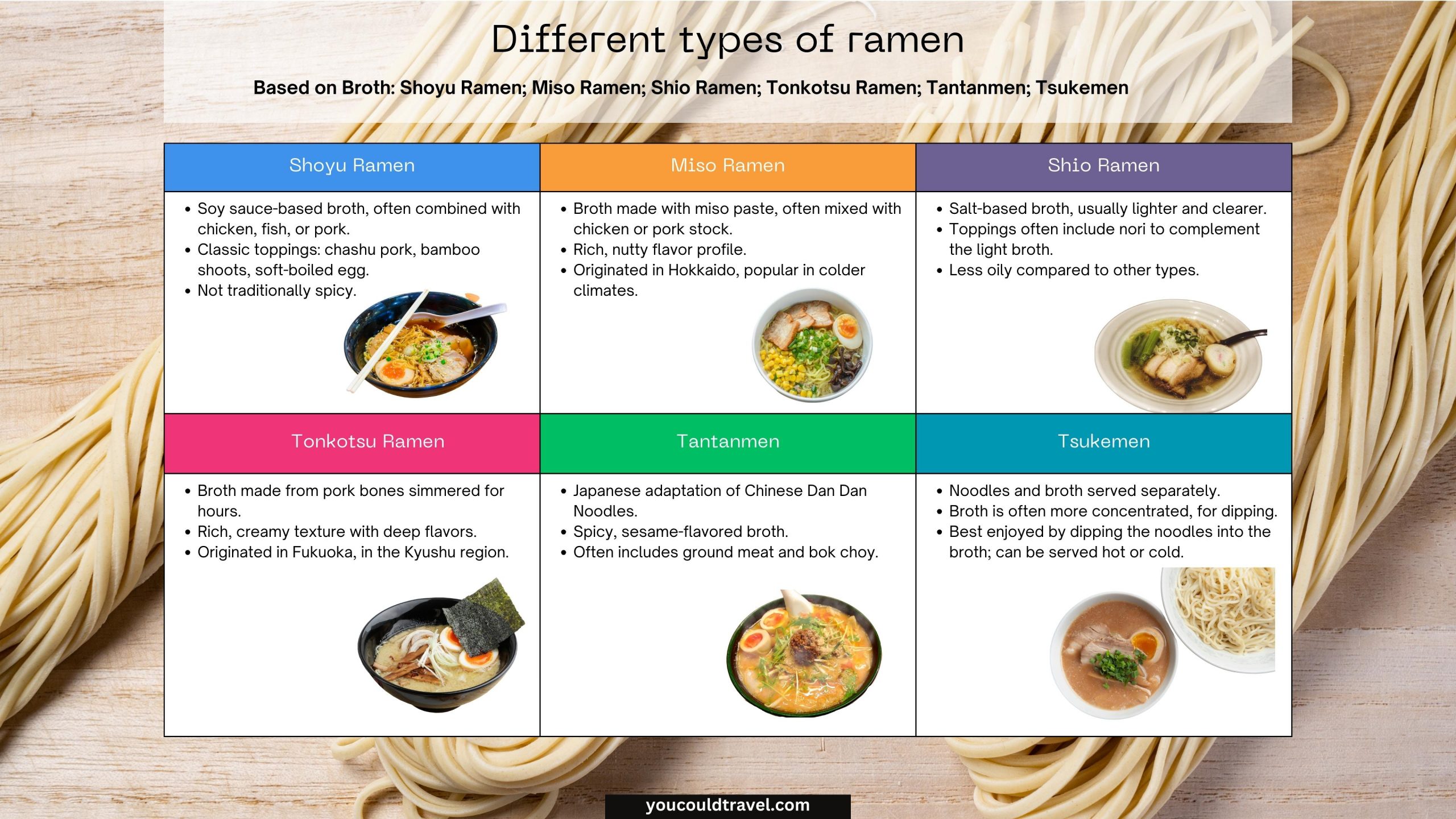
Understanding the different types of ramen starts with the broth, which lays the foundation for every sumptuous bowl. Here are some of the most common types of ramen based on their broth. In most restaurants, you will notice this to be the main point of difference between ramen bowls.
Shoyu Ramen

Shoyu ramen is a popular kind of ramen that many people love, both in Japan and other countries. It’s made with a soy sauce broth that commonly also has chicken, fish, or pork flavours mixed in. The broth is brown and smells really good, making it a favourite for many ramen fans. On top of the noodles, you get pieces of cooked pork, bamboo shoots, and a half-cooked egg.
Shoyu ramen has been around for a long time. People in Japan have used soy sauce for many years, and this dish got even more popular after World War II because it was tasty, filling, and not too expensive. You can find it in many places, from busy city restaurants to small local spots.
What makes shoyu ramen special compared to other ramens like shio, miso, or tonkotsu is the soy sauce. It gives the dish a deep, rich taste that’s different from the saltiness of shio ramen or the creamy flavour of tonkotsu ramen, which is made from pork bones. Miso ramen has a thicker, bean-like taste because it uses fermented soybean paste.
And no, shoyu ramen isn’t spicy. Some places might offer spicy versions, but the classic style aims to balance all the flavours without making it too hot or spicy.
Miso Ramen

Miso ramen is another popular type of ramen that uses miso paste for its broth. Miso paste is made from fermented soybeans, and when mixed with other ingredients like chicken or fish stock, it creates a thick, rich soup. On top of the noodles, you’ll often find toppings like corn, butter, and slices of pork, which make the dish even more hearty and flavorful.
Miso soup, which is the base for miso ramen, is typically made of miso paste, water or stock, and often includes other ingredients like seaweed or tofu. The miso paste gives it a full-bodied, nutty flavour that’s really unique. When it comes to ramen, the miso soup gets a bit of an upgrade with additional flavours and toppings, turning it into the rich and tasty miso ramen we all love.
Miso ramen has an interesting history. While ramen itself has been around for a long time, miso ramen is relatively younger and started gaining attention in the mid-1900s. It’s especially famous in Hokkaido, the northernmost island of Japan, where cold weather makes people crave its warm, filling goodness. Because of its hearty taste, it became popular pretty quickly, and now you can find it in ramen shops all over Japan and the world.
Shio Ramen
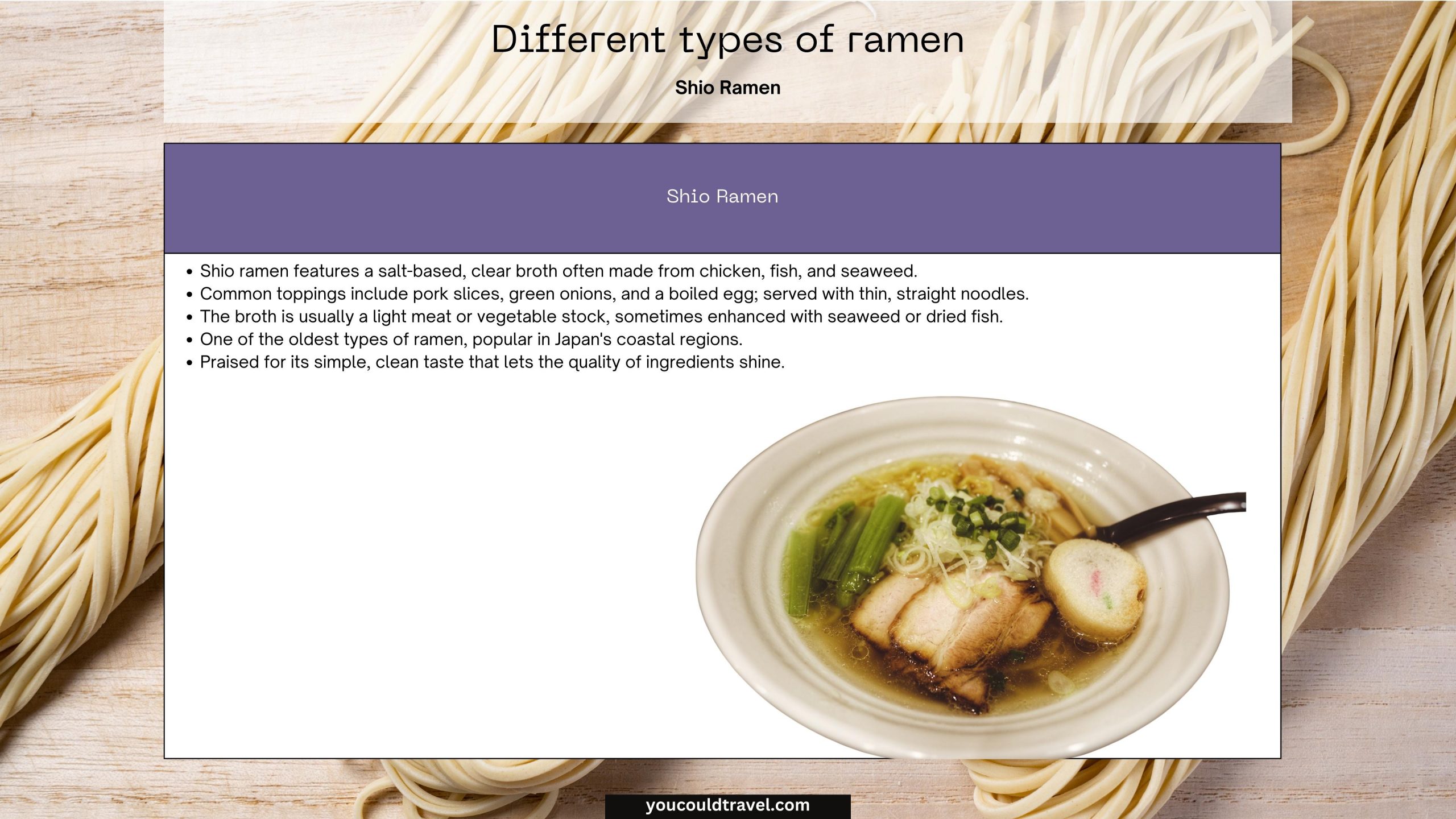
Shio ramen is a much-loved variety of ramen that uses salt as its main flavouring. The broth is light and clear, often made from a blend of chicken, fish, and seaweed. This gives the dish a straightforward, clean taste. Common toppings for shio ramen include slices of pork, green onions, and perhaps a boiled egg. The noodles are thin and straight, allowing the simple broth to shine.
As for the ingredients, shio broth consists of a light meat or vegetable stock, enhanced with salt. It’s not uncommon for it to include additional elements like seaweed or dried fish to round out the flavour. It’s the kind of soup that feels both comforting and refreshing at the same time.
Shio ramen is considered one of the oldest types of ramen. Salt has been a vital seasoning for centuries, making this style of ramen a classic. Shio ramen is particularly popular in the coastal regions of Japan. Its simple, uncomplicated flavour profile makes it a timeless choice, allowing the quality of the ingredients to take centre stage.
Tonkotsu Ramen
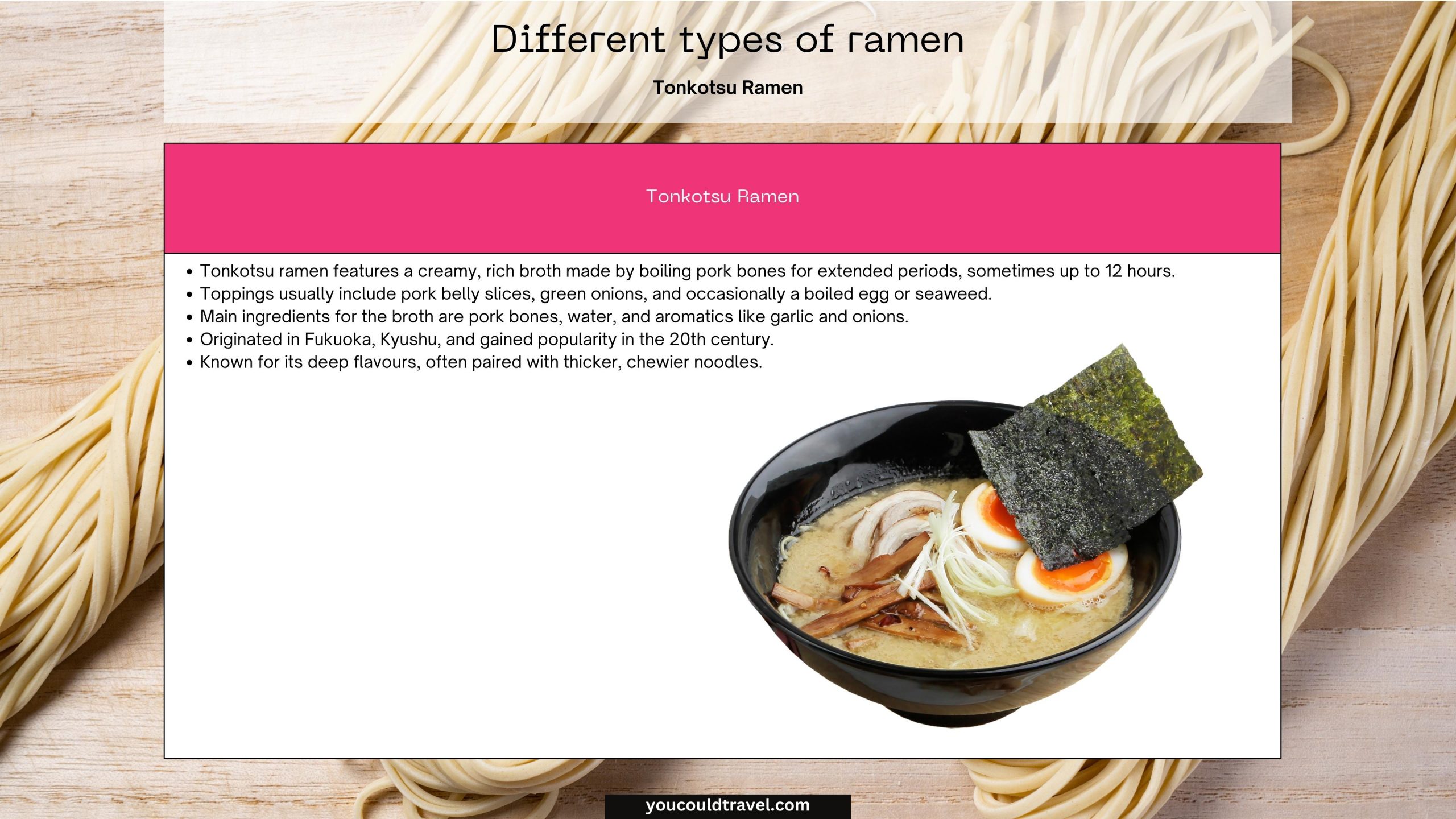
Tonkotsu ramen is a rich and creamy type of ramen that’s a big hit with many people. The star of the show is the broth, made by boiling pork bones for a long time, sometimes up to 12 hours or more. This process turns the broth white and creamy, full of deep flavours. On top of the noodles, you’ll find toppings like slices of pork belly, green onions, and maybe a boiled egg or some seaweed.
The main ingredients for tonkotsu broth are pork bones, water, and some aromatics like garlic and onions. Boiling the bones for many hours extracts all the goodness, making the broth thick and full of flavour. Because it’s so rich, the broth pairs well with thicker, chewier noodles that can stand up to the intense flavours.
Tonkotsu ramen comes from the southern part of Japan, particularly the city of Fukuoka in Kyushu. It gained popularity in the 20th century and quickly spread to other parts of Japan and, eventually, the world.
Tantanmen
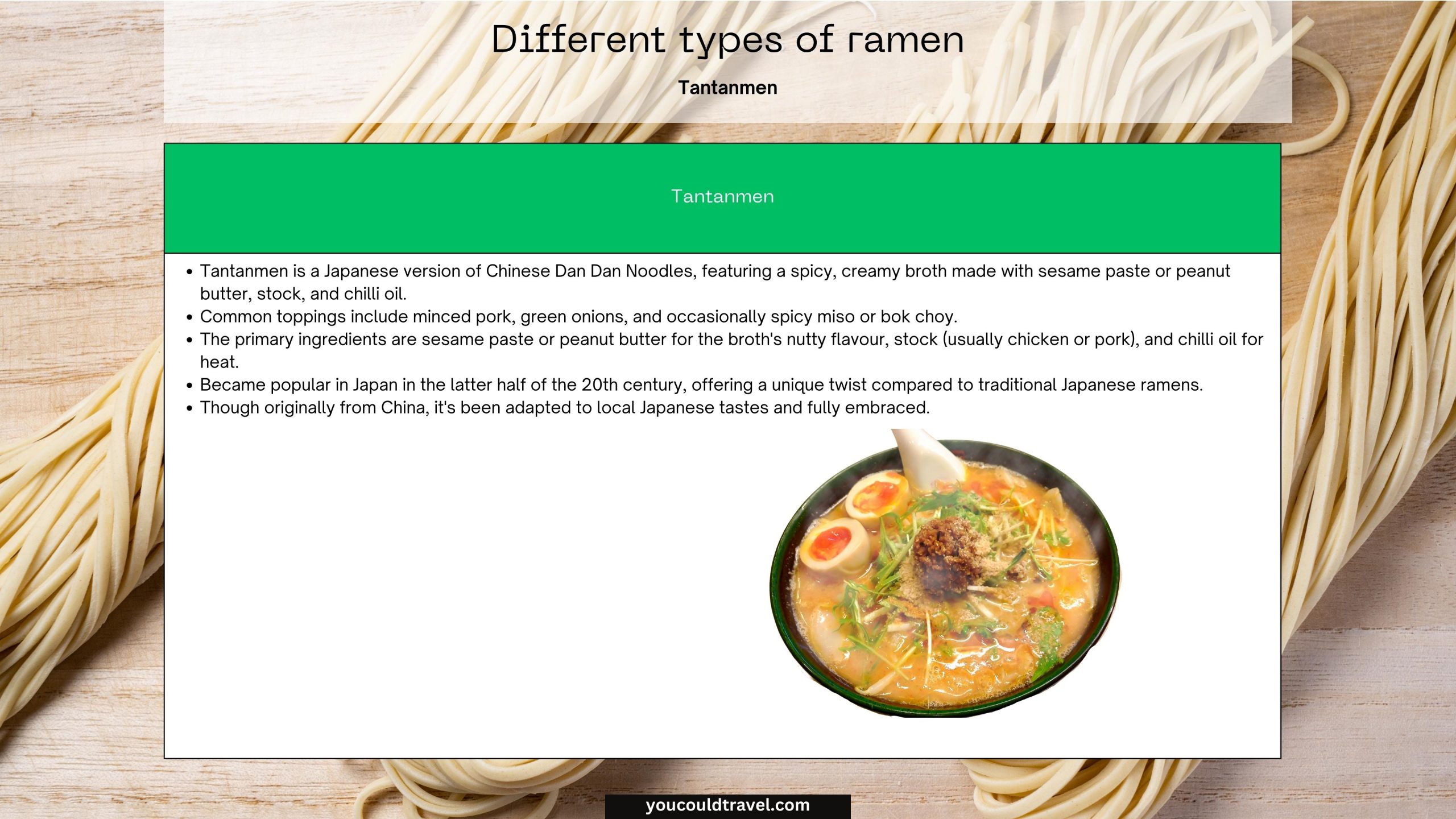
Tantanmen is a Japanese adaptation of the Chinese dish Dan Dan Noodles, and it’s a bowl full of exciting flavours. The broth is spicy and creamy, made with a mixture of sesame paste or peanut butter, chicken or pork stock, and chilli oil. It’s got a kick to it, but also a depth of flavour from the sesame that’s really satisfying. On top of the noodles, you’re likely to find minced pork, green onions, and even a dollop of spicy miso or bok choy for some greenery.
The primary ingredients for Tantanmen include sesame paste or peanut butter, which give the broth its rich, nutty flavour. Add to that some kind of stock, chicken or pork, and chilli oil for heat, and you’ve got a bowl that’s bursting with taste. Minced meat, often pork, is also a common element, adding a hearty meatiness to the dish.
Tantanmen is a relatively recent addition to the Japanese ramen scene. Originally from China, it became popular in Japan in the latter half of the 20th century. It offers a unique twist compared to the more traditional Japanese ramens like shio, shoyu, and tonkotsu. The dish has a multicultural background but has been fully embraced in Japan and adapted to local tastes.
Tsukemen

Tsukemen is a unique take on the ramen experience where the noodles and broth are served separately. Unlike the usual bowl of ramen where everything is mixed together, in Tsukemen you’re given a plate of noodles alongside a bowl of concentrated broth. You then dip the noodles into the broth before eating them. The broth is rich and full of flavour, often made from pork, chicken, or fish, and can include a hint of citrus like yuzu for an extra kick. Toppings include pork slices, seaweed, and perhaps a boiled egg or bamboo shoots.
The primary ingredients for the Tsukemen broth often include a meat or fish base, along with seasoning and vegetables to enhance the flavour. Because the broth is concentrated, it clings to the noodles better, giving you a mouthful of flavour with each bite.
Tsukemen originated in Tokyo in the 20th century and has quickly gained popularity for its unique eating style. It offers a different kind of noodle experience, emphasizing the interplay between the chewy noodles and the dense, flavour-packed broth.
Now, how are you supposed to eat Tsukemen? You grab some noodles with your chopsticks, dip them into the broth to soak up the flavours, and then eat them. It’s a more interactive way of eating ramen and many find it fun and engaging.
Is Tsukemen better hot or cold? That’s subjective and depends on personal preference and the weather. In the hot summer months, cold Tsukemen can be incredibly refreshing. On the other hand, hot Tsukemen can be comforting on a chilly day. Both versions work well, and it’s really up to what you’re in the mood for.
Different types of ramen based on toppings

When it comes to customising your ramen experience, toppings play a crucial role. They add layers of flavour and bring a variety of textures to your bowl. While the broth and noodles lay the foundation, the toppings are the finishing touches that can make each bowl unique. From the classics like sliced pork and boiled eggs to more adventurous options like corn and butter, the variety is endless. Read on to discover how different toppings can completely transform your ramen experience.
Chashu Ramen
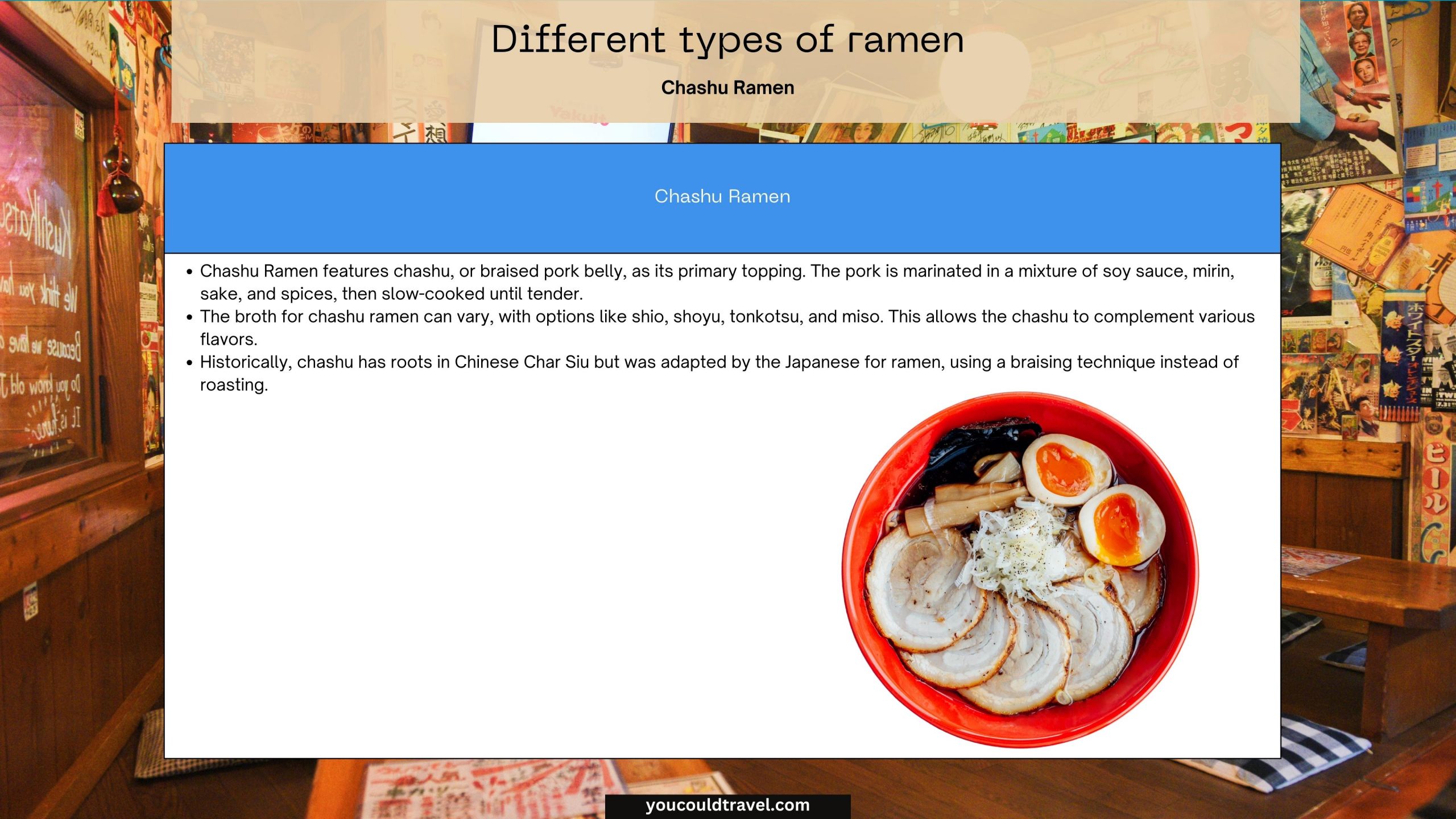
Chashu Ramen is a ramen dish that features chashu as its star topping. Chashu is essentially braised pork belly rolled into a log shape and sliced thinly. These succulent slices of pork add a delightful richness to your bowl of ramen, making each bite a heavenly experience. The noodles and broth serve as the backdrop, letting the chashu shine.
Chashu is made from pork belly marinated in a mixture of soy sauce, mirin, sake, and additional spices like garlic and ginger. The pork is then slow-cooked until it becomes tender and absorbs all those flavours.
As for the broth, chashu ramen doesn’t restrict you to one particular type. Whether it’s a light shio, a complex shoyu, a creamy tonkotsu, or even a spicy miso broth, chashu complements them all wonderfully.
Historically, chashu finds its roots in Chinese cooking, particularly the dish known as Char Siu. When ramen became popular in Japan, the Japanese adapted this Chinese-style barbecued pork to suit the ramen dish, braising it rather than roasting. Over time, chashu ramen has become a beloved staple, providing a meaty satisfaction to an already delightful bowl of ramen.
How do you eat chashu? Well, it’s already sliced and resting atop your ramen, ready to be savoured. You just use your chopsticks to pick up a slice along with some noodles and broth, making sure you get a well-rounded mouthful of flavours and textures. Each bite of chashu should be a perfect balance between the meat and the other components of the ramen.
Ajitama Ramen
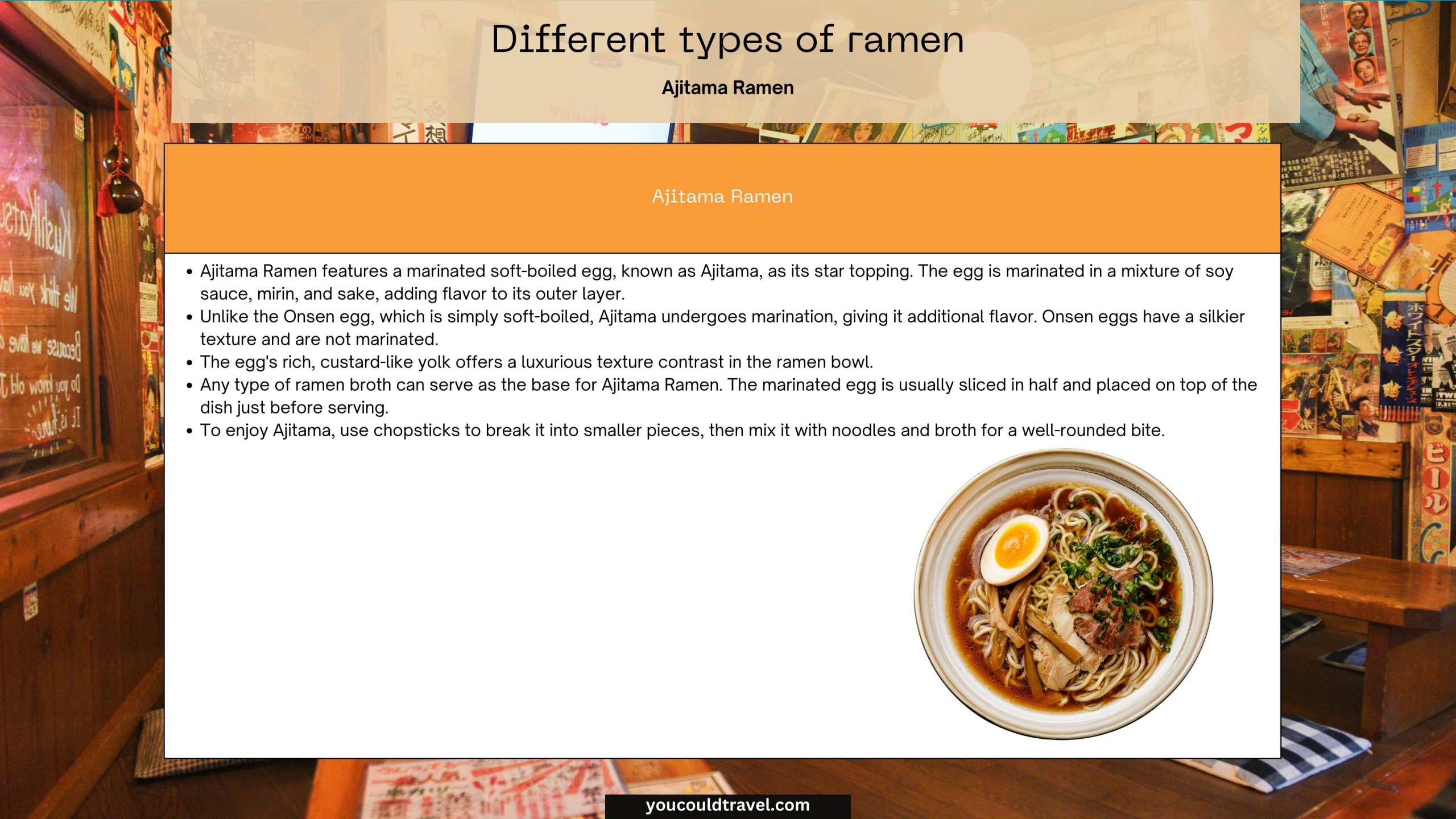
Ajitama Ramen is a ramen dish featuring Ajitama as its main topping, which is essentially a marinated soft-boiled egg. The egg is first soft-boiled, then peeled and marinated in a mixture of soy sauce, mirin, and sake, resulting in a flavourful outer layer and a gooey, rich yolk that enhances the ramen experience.
Ajitama serves as a complementary element that adds richness and depth to the dish. Its soft, almost custard-like yolk creates a luxurious contrast to the other textures in the bowl.
Don’t confuse Ajitama with Onsen egg, though, as they are both very different. Both are soft-boiled, but the key difference lies in the marination process for Ajitama, which adds more flavour. Onsen eggs, named after Japan’s hot springs where they were traditionally cooked, are not marinated and have a looser, silkier texture.
For Ajitama Ramen you can use any base of broth, be it tonkotsu, shoyu, or miso, and add your regular ramen toppings. The Ajitama is added just before serving. To prepare the Ajitama itself, soft-boil the eggs and marinate them in a mixture of soy sauce and mirin for several hours or overnight.
Generally, the Ajitama egg is sliced in half and placed atop the ramen. You can use your chopsticks to break it into smaller pieces that can be easily picked up along with some noodles and broth, making each bite a harmonious blend of flavours and textures.
Karaage Ramen
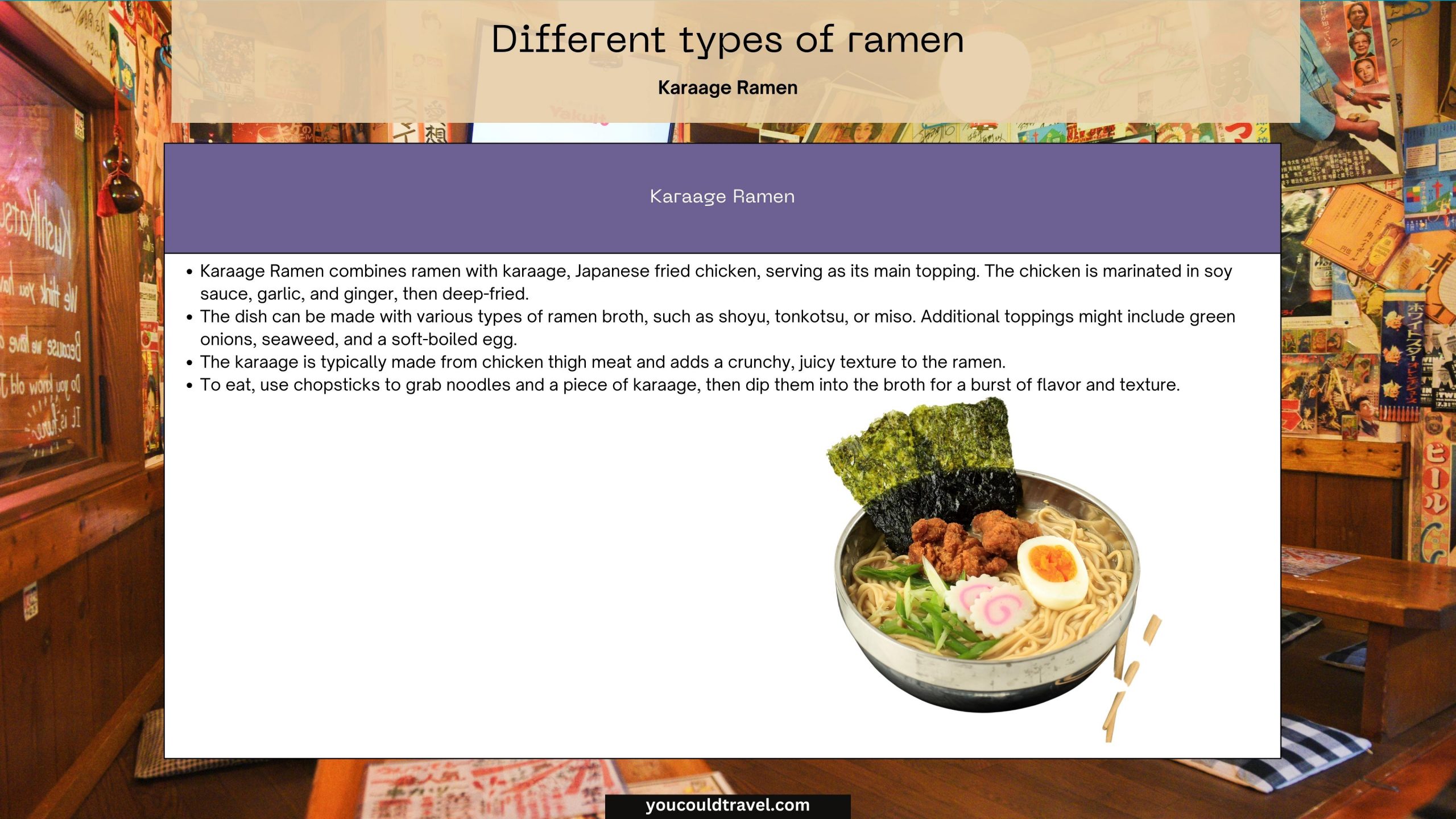
Karaage Ramen is a delicious fusion of two beloved Japanese dishes: ramen and karaage. Karaage is Japanese fried chicken that’s marinated in a mixture of soy sauce, garlic, and ginger before being coated in flour or potato starch and deep-fried to golden perfection. In Karaage Ramen, these crispy pieces of chicken serve as the main topping, adding both texture and flavour to the dish.
The ingredients for Karaage Ramen mostly include the ramen noodles and broth of your choice—be it shoyu, tonkotsu, or miso—accompanied by the karaage. The karaage itself is made from chicken pieces, commonly thigh meat, marinated and then coated for frying. Additional toppings might include green onions, seaweed, and perhaps a soft-boiled egg.
When it comes to eating Karaage Ramen, the approach is pretty straightforward. Use your chopsticks to grab some noodles and a piece of karaage, then dip them into the broth for a full-flavoured bite. The karaage adds a crunchy, juicy element that pairs wonderfully with the soft, slurpable noodles and the rich broth.
Gyoza Ramen
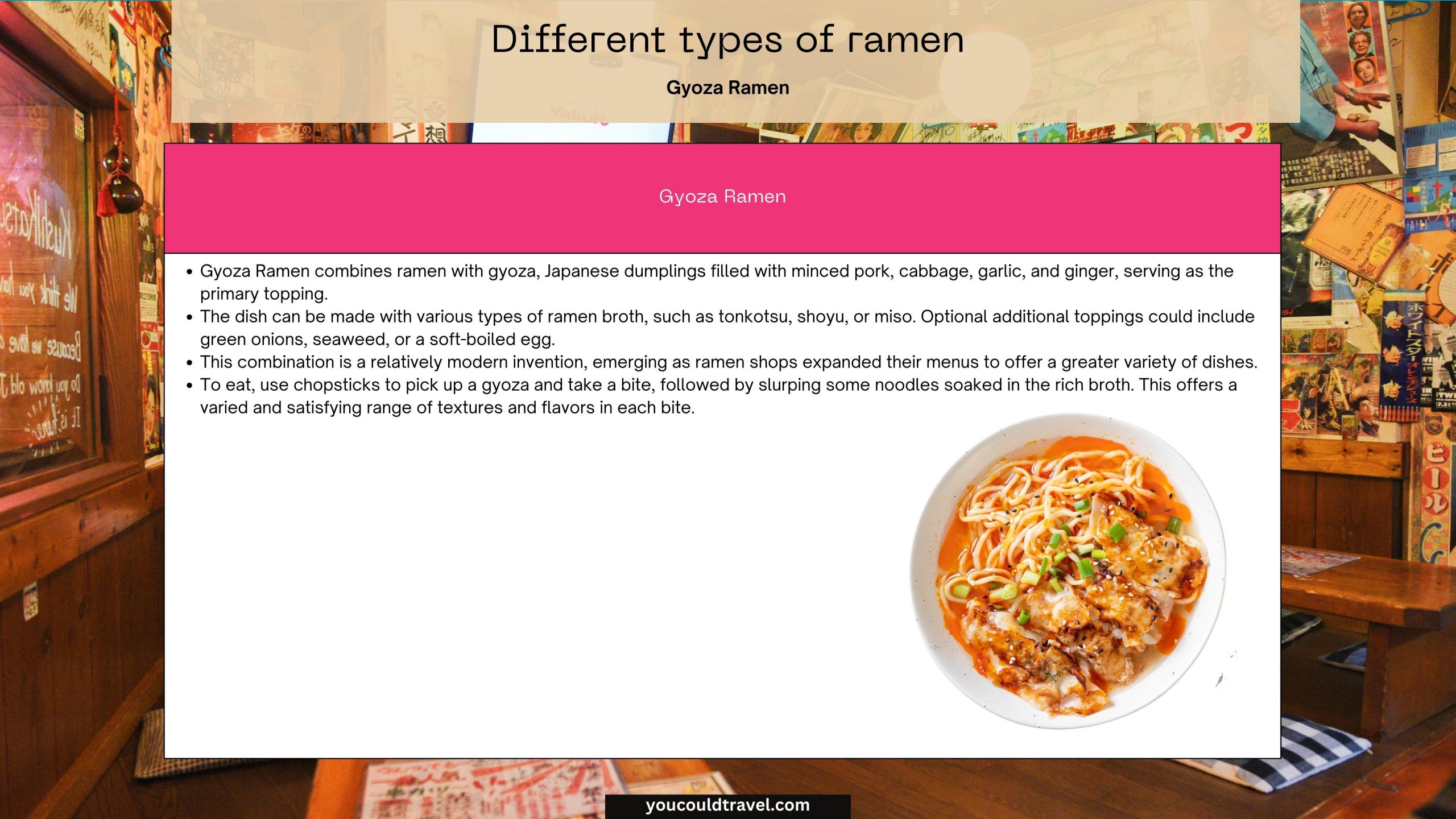
Gyoza Ramen is a delightful marriage of two Japanese favourites: ramen and gyoza. In this dish, gyoza—Japanese dumplings mostly filled with minced pork, cabbage, garlic, and ginger—are served as the primary topping for a bowl of ramen. This combination takes the best of both worlds to create a meal that’s satisfyingly varied in both flavour and texture.
The ingredients for Gyoza Ramen include your choice of ramen broth, whether that’s tonkotsu, shoyu, or miso, along with the noodles and, of course, the gyoza. Optional additional toppings might include green onions, seaweed, or a soft-boiled egg.
Gyoza Ramen is a relatively modern invention. While both ramen and gyoza have deep-rooted histories in Japanese cuisine, the combination likely emerged as ramen shops began expanding their menus to offer more variety. Now, it’s not uncommon to find this hearty, meaty bowl on the menu in restaurants or as a popular homemade dish.
Eating Gyoza Ramen is a straightforward but rewarding experience. Using your chopsticks, you can pick up a gyoza and take a bite, followed by some noodles soaked in the delicious broth.
Corn and Butter Ramen

Corn and Butter Ramen is a unique and indulgent variation of the classic Japanese noodle dish. In this version, kernels of sweet corn and a pat of butter are added as toppings, making for a rich and comforting bowl that’s especially popular in colder weather.
The essential ingredients for Corn and Butter Ramen include the base of ramen noodles and your choice of broth. The star toppings are, of course, sweet corn and butter. The corn provides a burst of sweetness and a bit of crunch, while the butter melts into the hot broth, creating a creamy, rich consistency.
Corn and Butter Ramen doesn’t have a long, storied history like some other types of ramen. It’s more of a modern innovation, likely inspired by the Hokkaido region’s love for dairy and corn. The dish has become particularly popular in places with colder climates, where the added richness and warmth are most appreciated.
Once the bowl is served, give it a good stir to make sure the melted butter is evenly distributed throughout the broth. This turns each spoonful into a creamy delight. You can use your chopsticks to pick up some noodles along with bits of corn, ensuring you get a full range of textures and flavours in every bite.
Negi Ramen

Negi Ramen is a variation of the traditional Japanese noodle dish where the star topping is negi, or green onions. These onions are finely chopped and generously sprinkled over the bowl, adding a bright, fresh flavour and a delightful crunch to each bite.
The primary ingredients for Negi Ramen are your chosen types of ramen noodles and broth. The crucial topping, of course, is a heaping amount of chopped green onions. You can also add other toppings like chashu pork or a soft-boiled egg, but the green onions are the real highlight here.
Negi Ramen can be seen as a nod to the simplicity and elegance of Japanese cuisine. This particular variation has become popular for those who appreciate the onion’s unique combination of sweetness and sharpness.
Now, what is Negibaka? “Baka” means fool or crazy in Japanese, so Negibaka refers to someone who is crazy about green onions. It’s a term of endearment for those who can’t get enough of this aromatic vegetable and would happily add it to every dish if they could!
Regional variations of ramen

Sapporo Ramen
Sapporo Ramen hails from the city of Sapporo in Hokkaido, the northernmost island of Japan. What sets Sapporo Ramen apart is its rich, miso-based broth. While you’ll find ramen made with various kinds of broth across Japan, Sapporo is particularly famous for pioneering the use of miso in ramen. This gives the dish a full-bodied, nutty flavour that’s satisfying and warming. Another distinctive feature is the thicker, curly noodles, which are well-suited for holding on to the hearty broth. Common toppings include sweetcorn, butter, and bean sprouts, all of which add to the richness of the dish.
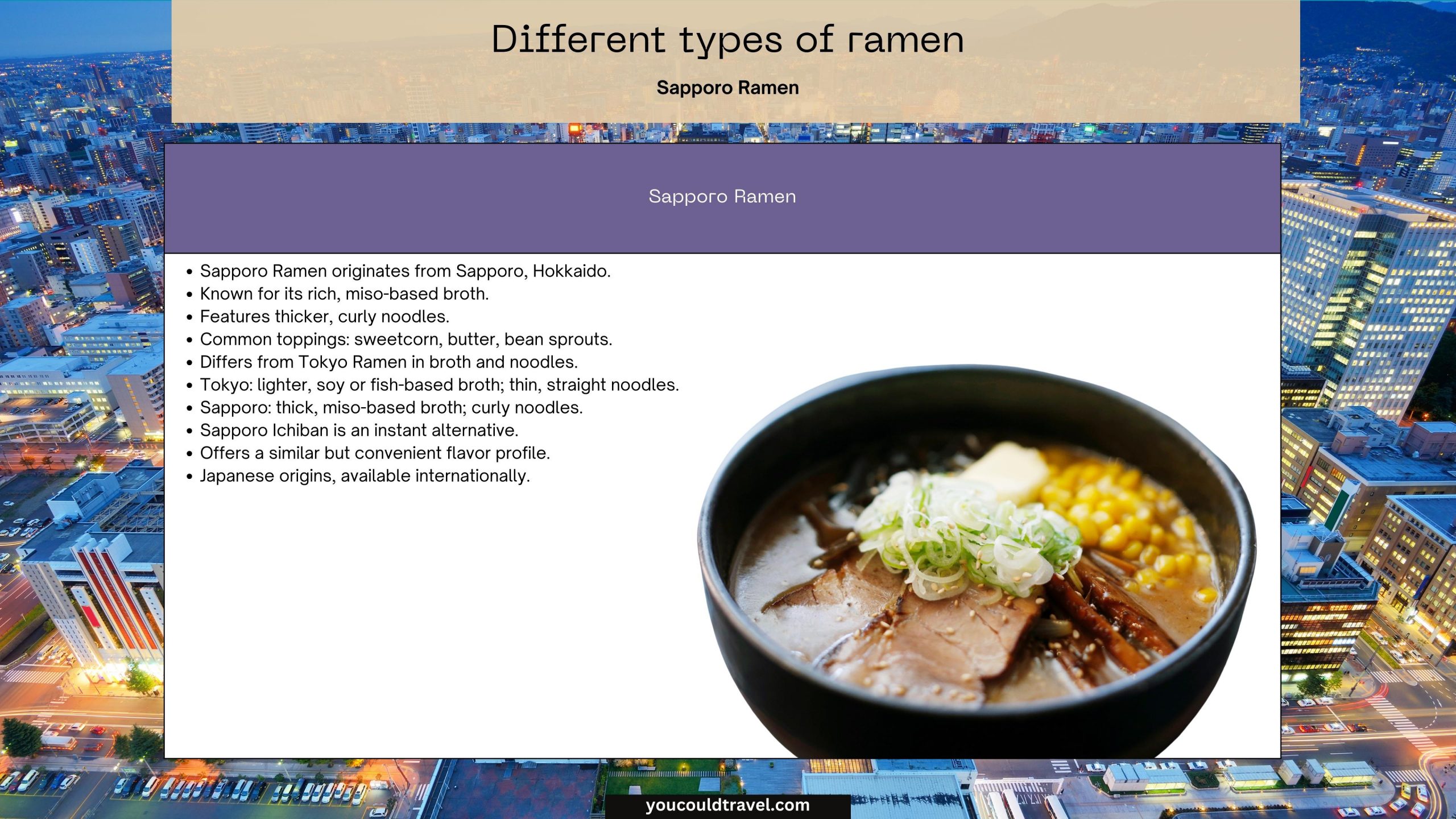
When you compare Tokyo and Sapporo Ramen, the most immediate difference is the broth. Tokyo Ramen often uses a soy-based or fish-based broth that’s lighter and less oily, while Sapporo’s is thick, rich, and often miso-based. The noodles in Tokyo Ramen are generally thin and straight, contrasting the thicker, curly noodles you’ll find in Sapporo Ramen.
Fancy Sapporo ramen without having to visit Hokkaido? I’ve got you. You need a pack of Sapporo Ichiban: This is a brand of instant noodles that, while not the same as traditional, freshly-made Sapporo Ramen, aims to offer a similar flavour profile. Though it’s widely available outside of Japan, the brand does have Japanese origins and attempts to replicate the distinctive taste of Sapporo-style ramen, albeit in a convenient, packaged form.
Hakata Ramen

Hakata Ramen originates from the Hakata district of Fukuoka city in Kyushu, Japan. It’s known for its straightforward and deeply flavourful broth made from pork bones. This type of ramen is topped with minimal garnishes, like green onions and char siu pork, allowing the creamy broth and thin, straight noodles to shine.
The hallmark of Hakata-style ramen is its tonkotsu broth, which is made by boiling pork bones for several hours. This process results in a rich, creamy, and slightly opaque broth that packs a flavourful punch. The noodles used in Hakata Ramen are thin and straight, specifically designed to cook quickly and absorb the broth well. Customarily, the ramen is served with minimal toppings to keep the focus on the noodles and broth, though some places will offer additional toppings like wood ear mushrooms or soft-boiled eggs.
So, what’s the difference between Hakata and Tonkotsu Ramen? The terms are often used interchangeably, and that’s because Hakata Ramen is essentially a subtype of Tonkotsu Ramen. Both feature a broth made from boiling pork bones for a long time. However, Hakata Ramen specifically refers to the style of tonkotsu ramen from the Hakata district of Fukuoka. It’s characterized by its thin, straight noodles and minimal toppings, whereas other variations of tonkotsu ramen might feature different types of noodles or a wider array of toppings.
Kitakata Ramen
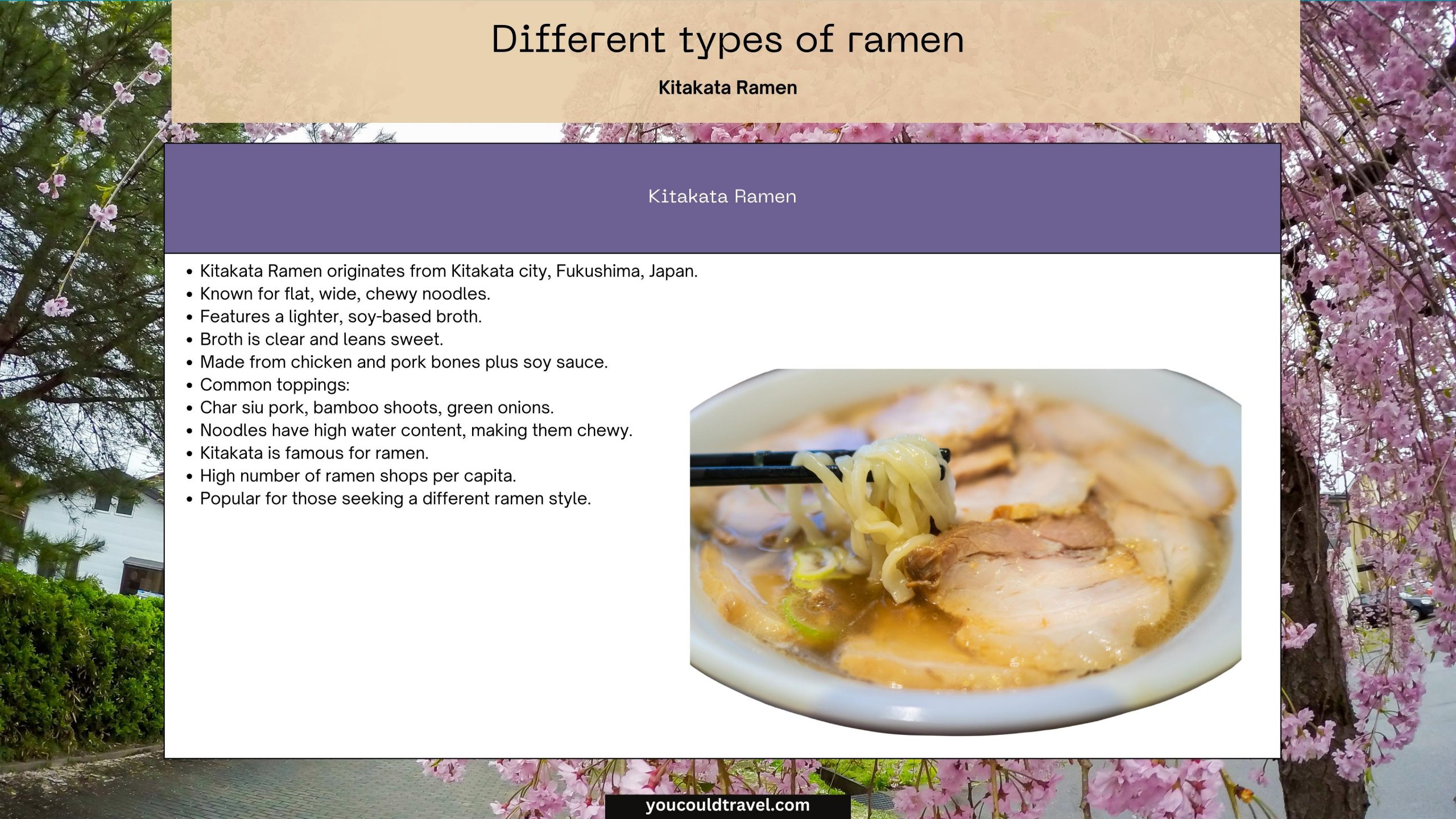
Kitakata Ramen comes from Kitakata city in the Fukushima Prefecture of Japan. Known for its distinctive, chewy, flat and wide noodles, this type of ramen offers a unique eating experience. The broth is soy-based, providing a lighter, cleaner flavour compared to the heavier, creamy broths like tonkotsu.
Kitakata Ramen is a clear, yet deeply flavoured soy-based broth that leans towards the sweeter side. The flat and wide noodles have a firm, chewy texture, contrasting the lightness of the broth. Toppings often include char siu pork, bamboo shoots, and green onions, adding layers of flavour and texture to each bite.
Kitakata Ramen is primarily made of three components: the unique, flat and wide noodles, the soy-based broth, and the array of toppings. The noodles are often made using a higher water content, which contributes to their characteristic chewiness. The broth is lighter and more nuanced, relying on a blend of chicken and pork bones along with a soy sauce seasoning to give it its characteristic taste.
The city of Kitakata is renowned for its ramen, to the point where it’s often said to have one of the highest numbers of ramen shops per capita in Japan. The locals are incredibly passionate about their regional dish, and it’s a point of pride for the city. The area is so synonymous with this style of ramen that Kitakata Ramen has become a popular choice for those looking for something a bit different from the typical ramen fare.
Tokyo Ramen
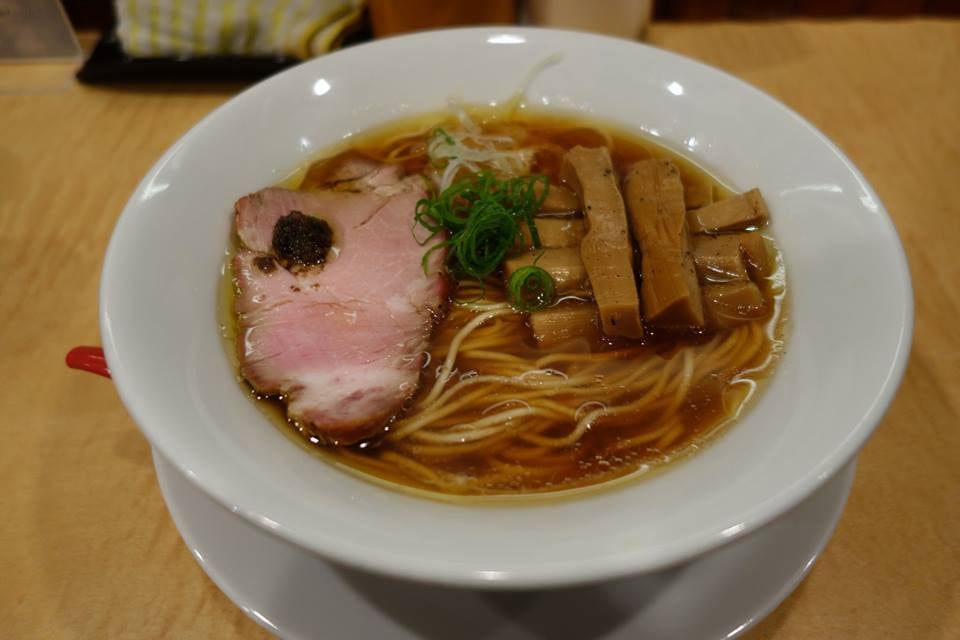
Tokyo Ramen is a versatile dish that reflects the cosmopolitan nature of Japan’s capital city. Tokyo-style ramen features a soy sauce-based broth, enriched with chicken, fish, or even pork. This results in a clear but deeply flavoured broth that can be both salty and a bit sweet. Toppings commonly include bamboo shoots, a slice of nori (seaweed), and char siu pork, all laid atop a bed of curly or straight, medium-thick noodles.
Tokyo-style ramen noodles are medium-thick and can be either curly or straight, offering a satisfying bite and a great ability to hold onto the broth. They’re made from wheat and have a firm texture, designed to maintain their integrity while you’re eating your way through the bowl.
As for the quality of ramen in Tokyo, the city is a haven for ramen enthusiasts. With a plethora of options ranging from old-school joints to innovative newcomers, Tokyo offers some of the best ramen experiences in the world. Whether you’re searching for a traditional bowl or something avant-garde, Tokyo’s ramen scene is both diverse and exceptionally high-quality. Not to mention, Tokyo is home to several Michelin-starred ramen shops!
Okinawa Soba

While not technically ramen, this dish is a local speciality featuring thick soba noodles in a clear broth.
Soba and Okinawa Soba are both noodle dishes, but they are quite distinct from each other in terms of ingredients, preparation, and historical background. Traditional soba noodles are made primarily from buckwheat flour and have a nutty, earthy taste. They can be served in a variety of ways, including cold with a dipping sauce or hot in a broth. Okinawa Soba, on the other hand, is a regional dish from Okinawa and its noodles are made from wheat flour. The noodles are thicker and somewhat resemble udon noodles. They are served in a hot broth made from pork and konbu (kelp), with toppings like green onions, red Kamaboko (fish cake), and stewed pork belly.
Okinawa Soba has a rich, savoury taste thanks to its pork-based broth. The wheat noodles are softer and chewier than traditional soba noodles, making for a hearty, filling dish. The soup often incorporates bonito flakes and soy sauce, adding layers of umami and a touch of sweetness.
The history of Okinawa Soba is entwined with Okinawa’s unique cultural history, influenced by its trading relationships with China, Southeast Asia, and mainland Japan. The dish has evolved over time, but it became particularly popular post-World War II, when food was scarce and people needed hearty meals. Over time, it has become a beloved comfort food and a symbol of Okinawan cuisine.
Modern ramen innovations
Vegetarian/Vegan Ramen
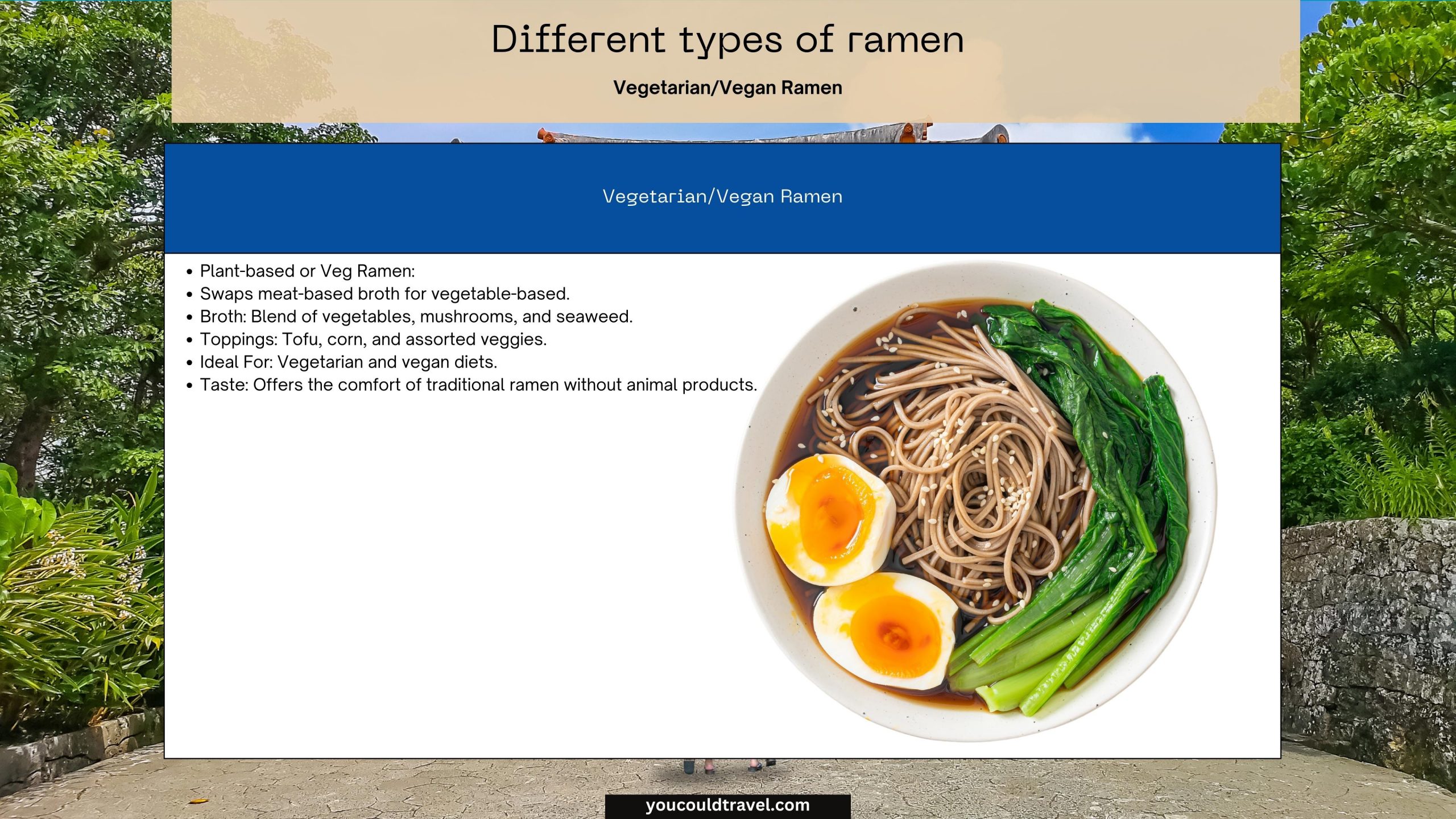
This version swaps the traditional meat-based broth for a plant-based one, often made from a rich blend of vegetables, mushrooms, and seaweed. The toppings are also plant-based, including things like tofu, corn, and various vegetables. This ramen is perfect for those following a vegetarian or vegan diet but still craving the comfort of a warm bowl of noodles.
Cold Ramen

As the name suggests, this ramen is served chilled, making it a refreshing option for hot summer days. The broth is lighter, served as a dipping sauce rather than in the bowl with the noodles. Cold ramen often features toppings like cucumber, boiled egg, and ham or cold meats, providing a unique and refreshing eating experience.
Curry Ramen

This is a fusion dish that combines the comforting texture of ramen noodles with the deep, complex flavours of curry. The broth is typically a mixture of a standard ramen broth and curry spices, offering a unique blend of flavours. Toppings can vary, but often include items that complement the curry flavour, such as boiled eggs, bamboo shoots, and slices of char siu pork or chicken.
Cheese Ramen
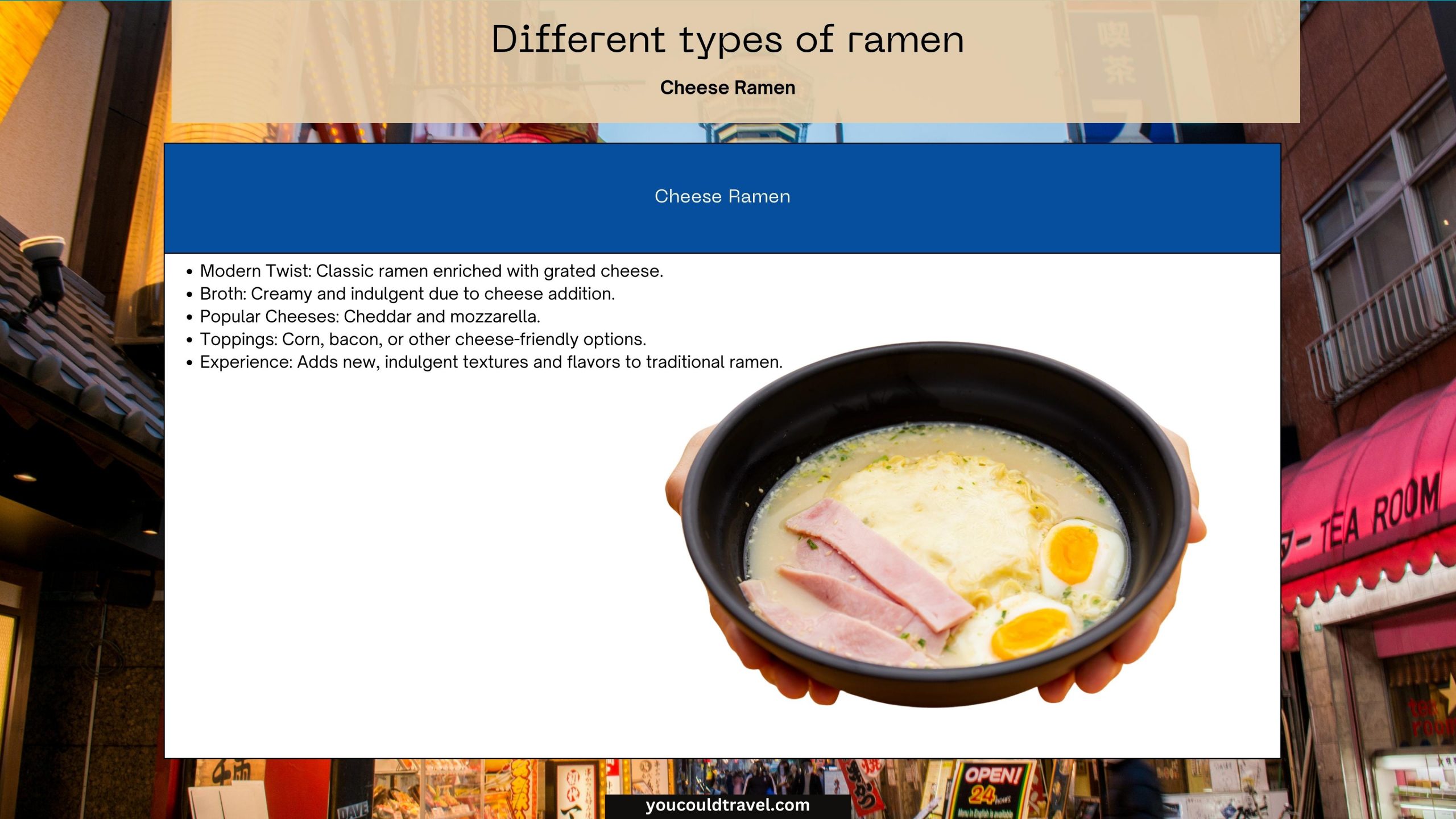
A modern twist on the classic dish, cheese ramen features a broth that’s been enriched with grated cheese. The result is a creamy, indulgent dish that brings new textures to the ramen experience. Popular cheeses to use include cheddar and mozzarella, and the toppings often include ingredients that pair well with cheese, like corn or bacon.
Spicy Ramen
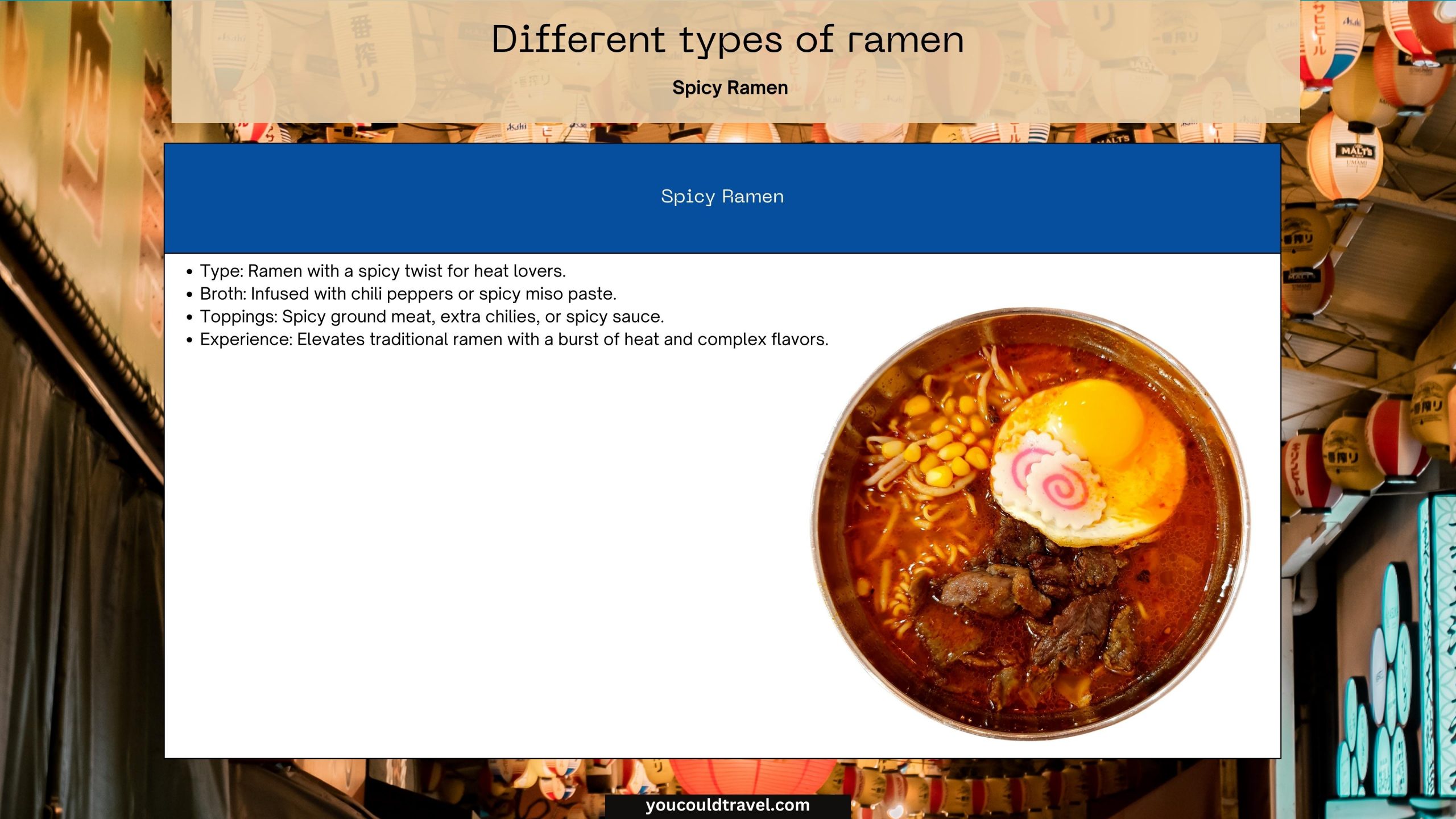
For those who love a kick, spicy ramen is infused with a range of spices to elevate the heat. The broth is often made spicy with the addition of ingredients like chilli peppers or spicy miso paste. Toppings can include spicy ground meat, extra chillies, or even a dollop of spicy sauce to really turn up the heat.









Leave a Reply